The drag race of rowing: How Australia plans to break a 124-year drought in the eights
By Iain Payten
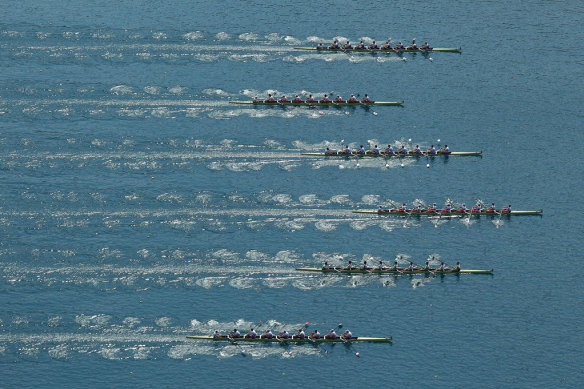
The eights are rowing’s version of drag racing: get out fast and stay in front.Credit: Richard Heathcote/Getty Images
They are human-powered speedboats, weighing about a tonne and with a noisy “engine” of eight giant rowers, heaving and straining and pushing their bodies to exhaustion.
But when the crew of a rowing eight puts all the parts in perfect harmony, the effort seems to drop away, and so, too, the racket.
“It’s quite ethereal, almost,” three-time Olympic rower Jaime Fernandez says.
“You hear the bubbles under the boat, the fin might be humming a little. And the boat is almost effortless.
“There were moments where I can remember, and picture, sitting in the boat thinking, ‘Should it feel this easy?’. Particularly in that 2000 crew, we had moments where you sat there thinking this is what it feels like when you are in sync, and in harmony.”
Fernandez rowed in the Australian men’s eight at three Olympic Games, and the crew in Sydney was the best of them. But with Fernandez at stroke, even that superb boat didn’t achieve its goal of winning gold; finishing with silver behind Great Britain by an agonising 0.8 of a second.
It is still the closest any crew has come to catching the white whale of Australian rowing: an Olympic gold medal in the coxed eights, men or women.
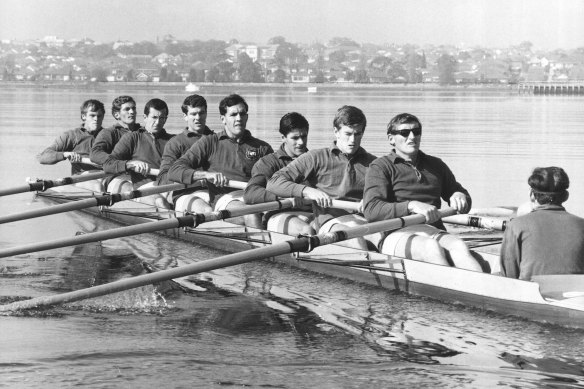
The 1968 Australian men’s eight rowers, who won an Olympic silver medal.Credit: Colin Bullard
Australia is one of the world’s best rowing nations, but since the men’s eights first raced down the Seine in Paris in 1900, Australian crews have finished with six medals but never bettered a pair of silvers, in 1968 in Mexico City and Sydney in 2000. Since the women’s eights event was introduced in 1976, the Australian women’s crews have not medalled.
The Australian rowing team hopes to change that in Paris.
What is Australia’s aim in 2024?
Catch the bloody whale. In both the men’s and women’s Olympic teams, selectors have made the eights a “priority boat”.
In layman’s terms, they have stacked the Australian eights with most of the nation’s best rowers, instead of the recently preferred tactic of dividing them between smaller boats, which gives the best chance of a number of medals.
In the men’s crew, three of the four men who won a gold in the coxless fours in Tokyo have been put in the eight: Alex Purnell, Jack Hargreaves and Spencer Turrin.
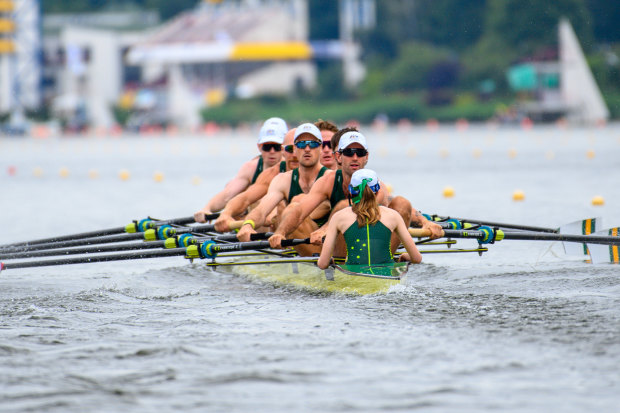
The Australian men’s eight in Poznan in June.Credit: Rowing Australia/Vera Bucsu
“It has historically been the blue-ribbon event at the Olympics, and Australia has never won a gold medal at the Olympics, so everyone recognises that there is an opportunity there,” Purnell said.
“We are super excited. It is a new challenge for us.”
In the women’s eight, a similarly strong crew has been assembled. The women’s four, who also won gold in Tokyo, was split up, and though Annabelle McIntyre and Jessica Morrison were put in a pair, Lucy Stephan was deployed to the women’s eight to strengthen its chances.
Why is the eights race so special?
The Oarsome Foursome, and those tinned fruit ads, skew the picture in Australia, but ask most people around the world to picture a rowing race and they’ll see the eights.
It is the race made famous by Oxbridge crews on the Thames, traditional schools regattas, the US college system and even Hollywood. The Boys in the Boat was a George Clooney-directed feature film released last Christmas about the US gold-medal crew of 1936, starring Joel Edgerton.
“There is always a lot of romance around the eight, which I love. That’s the boat I spent a lot of time in,” Fernandez said.
“It is a boat that many countries love to win. It is the biggest boat, it is going the fastest, it is typically at the end of a regatta so it brings with it that sort of feeling. But you might argue a single scull is the one true world champion in our sport, because it is the one person who does it by themselves.
“But the eight gets some of the kudos it does because it is the main focus for a lot of countries.”
The most successful nations in the men’s eight have been countries with the greatest depth, and a cultural attachment to the eight. The USA (12) and Great Britain (4) have won the majority of Olympic golds, but Germany, Canada and the Netherlands have also won. New Zealand have won two gold medals in the eight, including the last one in Tokyo.
Since the women’s eight was first raced in 1976, the USA (4), Germany (3), Romania (3) and Canada (2) have been the gold medal heavyweights.
How do you win a gold medal in the eights?
Putting a crew together capable of winning a gold medal in the eights is, obviously, difficult. For Australia, at least.
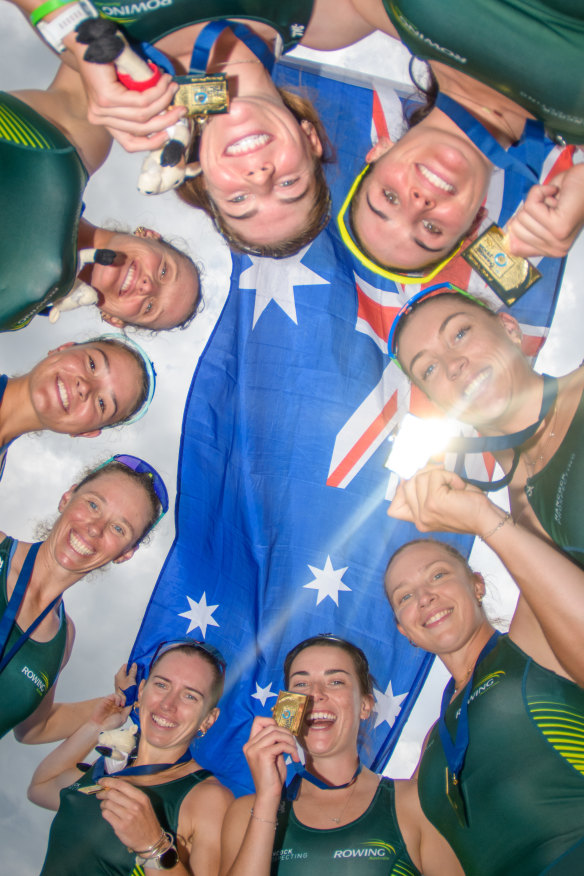
The Australian women’s eight in Poznan in June.Credit: Rowing Australia/Vera Bucsu
“It is one of the hardest boats to get everything right in,” Fernandez said. “It has the most number of people, it is the biggest boat, there are just factors impacting it being successful or not. Some of those factors are personality, experience, physicality … all of those go into making that combination work, or not work.”
After retiring post-Sydney, Fernandez worked in high performance for Rowing Australia for 11 years, and recently took up a similar role at Rugby Australia.
There are some similarities with rugby, in the sense that teamwork, a strong culture and a shared mindset is essential. But with the added requirement to be faultless with rhythm, skill, touch and synchronicity, the analogy only works if you also put that footy team in an orchestra and ask it to play Mozart’s fifth.
“And the other part is when you have to do it, you have to do it,” Fernandez said.
“You can’t be, ‘I’ll do it next time’. In rowing or an Olympic sport like that, it is literally one shot to get it right. In rowing, if you make an error in a certain part of a race, well, you’re usually done. In footy, you can make an error and reset and go again.”
The eights crews take about 5:30 to travel 2000m, with an average speed of about 20km/h. Hollywood may show boat races with multiple lead changes but it doesn’t usually happen in the eights. Data shows if you’re leading at the 500m mark, you’ll win more than 90 per cent of races. Lead at 1000m, it goes above 95 per cent.
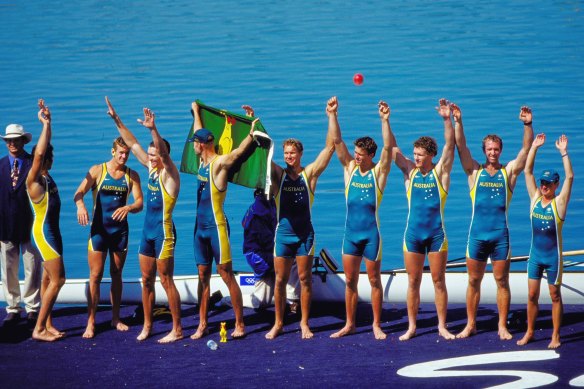
The Australian men’s eight won silver in 2000 in Sydney. Jaime Fernandez is second from the right.Credit: Getty
“Our mistake in Sydney, for whatever reason, is we got out slow and we had to overcome that. And we nearly did,” Fernandez said.
“So getting the boat up and moving off the start is highly important, and then to be able to hold it at pace for a long time. You sit at that threshhold between too hard or too little, and it is a very fine line.”
How is a crew put together?
There are eight rowers and a coxswain in a coxed eight. Rowers are typically tall and, for their height, lean and muscular. Male Olympians will be usually about 190-195 centimetres tall and weigh 90-95 kilograms. Female Olympians will be 180-85 centimetres and 75-80 kilograms.
The height enables a long reach, which maximises the amount of time an oar can be pulling in the water.
Coxswains are the jockey-sized “captains” of the boat, who steer and bark instructions at the crew. They are small and light, to minimise the overall weight of high-tech carbon-fibre boats, which international rules stipulate must weight at least 96 kilograms.
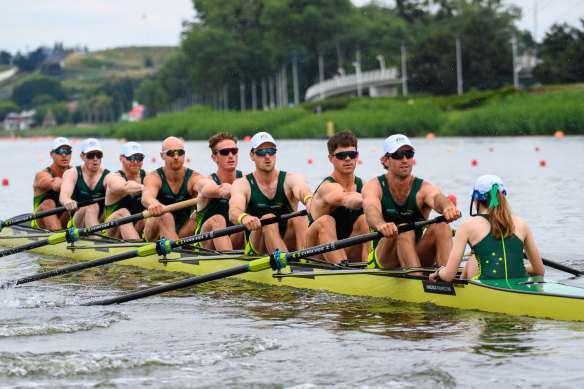
The current Australian men’s eight racing at the World Cup III regatta in Poznan.Credit: Rowing Australia/Vera Bucsu
Not every member of the eight is an athletically tall clone, however. Like positions on a footy team, there are several very specific roles.
At the front of the boat, the stroke is responsible for setting the tempo, and the seat behind is effectively the same role but for the opposite side to the stroke.
The six seat is a driver of the rhythm but is also part of the “engine room” pack in the middle of the boat. Rowers in seats six, five, four and three are typically the workhorses of the eight, and will often be slightly bigger and stronger, and post the best ergometer times.
The bow pair – the bow and the two-seat – are furthest away from the stroke and often the most skilful technically. Travelling at top speeds of 23km/h, the bow of an eight can lift higher in the air at full tilt, and even porpoise. So the bow pair have to be able to adapt throughout.
“There is a lot more noise going on, because there are obviously more athletes in the boat,” Purnell said.
“There are more people and more individuals and you have to bring them together. It is more hardcore. Everyone has their different strengths that they can bring to a crew.”
Is Australia any chance of winning gold?
That’s the million-dollar question. In two major international outings this year, the Australian men’s eight finished fourth in a stacked World Cup final and then won a second World Cup event, albeit with a weaker field.
And the women’s eight did exactly the same thing. Fourth, and then first.
Both are right in the mix for a medal of some colour, but will need to row with absolute perfection to break the gold drought.
But here’s the rub. Both men and women have gold medallists in their crew – and they know what it takes.
Purnell nods: “We are going to give it a red-hot crack.”